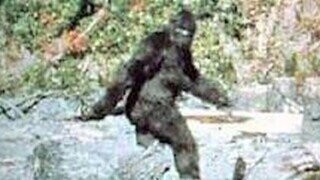All the Ways Science Has Tried to Prove Bigfoot

Whether you want to kiss him or simply want to believe, there’s a reason the mythology of Bigfoot has endured for possibly hundreds of years. After all, the idea of a large ape-like creature living in the forest isn’t that much of a stretch, considering the existence of, you know, apes, but those biologists sure are horny for the discovery of new species, so they’ve done their best to find him. Is it possible this elusive gentleman simply doesn’t want to be found? Probably not. Probably.
The Bigfoot Trap

In 1974, the North American Wildlife Research Team set up a trap in Jacksonville, Oregon, where he’d allegedly been recently sighted. They spent six years dutifully filling it with animal carcasses to lure the hairy guy out, but all they caught was a bunch of bears, one very confused and upset dude, and zero Bigfeet.
The Olympic Project

There are entire groups of scientists dedicated to hunting down Bigfoot, such as The Olympic Project, which seems to mostly take people out on Bigfoot expeditions and analyze audio recordings of alleged Bigfoot song. Inconsistent descriptions of vocalizations has been a major hindrance to the Bigfoot-believing community, so nailing that down is a key part of the “toldja so” picture.
The “Sierra Sounds”
In fact, the only recording that’s come anywhere close to being validated is the so-called “Sierra Sounds,” which a retired Navy linguist confirmed are “definitely a language” that is “definitely not human in origin” and “could not have been faked.” He won’t say it’s Bigfeet, though, and “to know what they were saying, we’d actually have to sit down with the speaker and verify word by word,” which doesn’t seem likely to happen anytime soon.
The Bigfoot Field Researchers Organization
There’s also the Bigfoot Field Researchers Organization, who mostly appears to just catalog reported sightings but claims to be “The only scientific research organization exploring the bigfoot/sasquatch mystery.” Don’t tell them about the Olympic Project.
Tracking Bigfoot

We may not know what Bigfoot is, but we definitely know where he is. In 2009, the Journal of Biogeography published data from scientists who used ecological niche modeling to predict the distribution of Bigfoot populations in western North America based on reported sightings. It turns out they track pretty closely with the distribution of black bears, but that’s probably a coincidence.
Bigfoot Hair DNA

In 2014, the freaking University of Oxford sequenced the DNA of a bunch of alleged Bigfoot hair and found that almost all of it was boring farm animals and even a few racoons. They thought they might have identified one new non-Bigfoot species, but it turned out to be a known (but still very rare and cool) bear.
The FBI Does Bigfoot

For more than 40 years, the FBI maintained a file on Bigfoot which they released in 2019. The file was basically just communication between one agent and a Bigfoot researcher regarding 15 alleged Bigfoot hairs, which turned out to be deer, but still. Somewhere in Washington was a tiny but foreboding file labeled “Bigfoot.”
Bigfoot’s Walk

(René Dahinden/Patricia Patterson)
You know that image of Bigfoot glancing back that adorns t-shirts and bumper stickers all over the Pacific Northwest? It comes from the Patterson–Gimlin film, a roughly one-minute recording of an alleged sighting that remains Bigfoot believers’ best evidence, since it’s never been conclusively debunked. One of the reasons is the way the creature on the tape walks, which was analyzed and not convincingly replicated by Motion and Gait Analysis Lab at Stanford, who seem like the people to ask. Others say it can be replicated, which is why we’ll be arguing about this as long as the end of Inception.
Hollywood Weighs In

Another factor is the monkey suit, if that is indeed what it is, shown in the film. Tons of Hollywood special effects artists have been asked about it, from Bill Munn, who claimed he “couldn't have come up with anything close to a man in a suit that looked like that” even though he “was the best there was in special effects,” to Stan Winston of Jurassic Park fame, who said that “if one of my colleagues created this for a movie, he would be out of business."
The Centralia Bones
In 2015, a professor of Centralia College claimed to have found bones near Mount St. Helens that appeared to have been gnawed on by human-like teeth, except the bites were more than twice as wide as a human’s. The Department of Fish and Wildlife could only rule out all the area’s natural predators, and he and his students also claim to have found footprints, though no scientists of higher authority seem to have attempted to verify the finds, probably because he theorized the creature was the result of Native American and ape interbreeding and no one wants anything to do with that.
The Dermal Ridges Question
Jeff Meldrum, an anthropologist with a specialty in bipedalism, has a collection of 300 alleged Bigfoot prints (and presumably not many dinner guests) that he insists couldn’t have been faked. They’re not shaped like a human foot, so they couldn’t just be a blown-up footprint, and they have “skin ridges” that can’t be replicated. Except one guy did demonstrate the replication of such skin ridges, though Meldrum would only concede that it was possible in that specific case.
The Gigantopithecus Theory

Anthropologist Grover Krantz “attempted to prove existence by applying to the problem the techniques of physical anthropology,” arguing that it was a descendent of an Asian ape called Gigantopithecus that migrated over on the Bering Land Bridge. That’s slightly complicated by the fact that no Gigantopithecus fossils have been found in America and the species probably couldn’t have looked anything like Bigfoot, but other than that, who can say?
The Paranthropus Theory

John R. Napier, a “leading authority on primate taxonomy,” suggested instead that Bigfoot is a species of Paranthropus. They would have looked more like Bigfoot, but their fossils have never been seen outside Africa, which is a long way to travel to be spotted in the California redwoods.
The DeNovo Fiasco
In 2012, veterinarian Melba Ketchum declared that she had DNA proof of a new half-human, half-primate species, but weirdly enough, she couldn’t get a single scientific journal to work with her, so she just created her own and published her findings without bothering to go through peer review. If she had, she would have been told, as one Princeton geneticist put it, that her data was flawed because “analyses either come back as 100 percent human or fail in ways that suggest technical artifacts.”
ZooBank

But Ketchum wasn’t deterred. In 2013, Homo sapiens cognatus, her name for Bigfoot, was added to ZooBank, the official registry of species names. That’s right: According to the International Commission on Zoological Nomenclature, Bigfoot exists. Apparently, their only criteria is that a species is named in a scientific journal, no matter how made up that day, and when a Bigfoot enthusiast reached out for comment, an unnamed “expert” simply said that “all the requirements for establishing the new name were fulfilled” so they had “no grounds to reject the scientific name.” Basically, “We didn’t think of that, so shut up.”
Top image: René Dahinden/Patricia Patterson